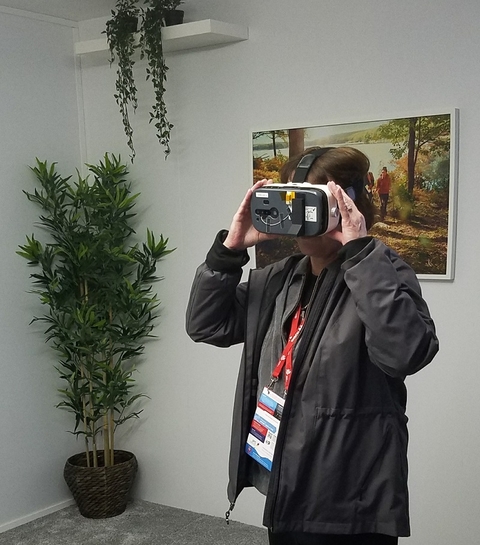BARCELONA, Spain—Qualcomm engineers have been working behind the scenes to improve virtual reality (VR) technologies ahead of 5G, and the results were on display in private demos at Qualcomm’s booth during Mobile World Congress 2018.
Latency is a tricky thing when it comes to VR because if the latency significantly exceeds 50 milliseconds, end users tend to start to feel sick; the motion and interaction get disorienting and cause nausea.
The best-designed LTE radio network under the best conditions yields about 35 milliseconds of latency from the tower to the device; then, if you have content rendered in the cloud and other factors, you add time on top of that and more delays, explained Peter Carson, senior director of marketing at Qualcomm Technologies.
However, Qualcomm engineers came up with the idea to use an 802.11ad access point at millimeter wave to essentially collapse the latency as if the radio layer doesn’t exist, he said. Inside the device, they’re doing some fancy latency work as well in the form of error correction and other techniques.

The end result is a rendering of frames that’s probably comparable to the best VR experience that you’d get on a laptop today, only this is being done on a phone—no tethering. The edges are sharp and the experience makes you feel as if you’re right there with the characters in the story. (This reporter got a demo and it looked great, but full disclosure: I don't have a lot of experience using VR.)
Carson pointed out that the demonstration used a Snapdragon 835-based phone—not even the most advanced in Snapdragon technology, so presumably it’s only going to get better.
“When 5G comes along, it’s going to cause, we believe, a change to the way people view the edge of the network,” he said. Qualcomm’s studies are showing that millimeter wave will produce 3-millisecond latency in good conditions. “When you get to the next-generation core network in standalone 5G, you’re going to get to potentially—with ultralow latency implementation—even submillisecond latency,” but that’s further down the road.
“This is very disruptive, and it’s going to accelerate much better VR experiences in mass market devices, much faster than people think,” he said.
Of course, part of the reason it works has to do with how they’re configuring things. “If we did everything on the device, we could not get this level of quality,” said Sebastien Mounier, senior director of engineering at Qualcomm Technologies. “If we did everything on the cloud, we’d have too much latency.” So they leverage the computing resources on both sides to provide an experience that’s better than individually.
RELATED: Qualcomm buys AI company Scyfer, continues focus on end devices
Qualcomm is just now showing this VR technology to carriers using a regular-sized smartphone-shaped test device, and it’s too early to guess when it might end up in commercially available smartphones, but they’re looking at use cases that leverage 5G capabilities. The framework is applicable to AR, but they’re just showing it in VR right now.

